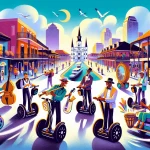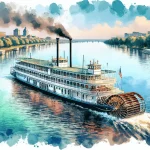Mardi Gras Indians Super Sunday is a treasured occasion celebrating the rich tradition of the Mardi Gras Indians in New Orleans. This cultural phenomenon blends African and Native American influences, showcasing the intricate artistry and profound meaning of hand-sewn suits, music, and dances passed down through generations.
In This Article
TL;DR
- The Mardi Gras Indians trace their origins to the 19th century, fusing African and Native American cultural elements.
- Super Sunday serves as a platform for tribes to showcase their intricate suits, engage in traditional chants and dances, and foster community pride.
- The event offers an immersive experience for participants and spectators, allowing them to appreciate the deep history and cultural significance of the Mardi Gras Indians.
Historical Context and Significance
Origins of Mardi Gras Indians
The Mardi Gras Indian tradition traces its roots back to the 19th century when African Americans in New Orleans were excluded from participating in the city’s white-dominated Carnival celebrations. As a response, they created their own vibrant custom, drawing inspiration from the Native American tribes that had provided refuge to escaped slaves. This fusion of African and Native American cultures gave birth to the Mardi Gras Indians, a community that honors their ancestors through intricate hand-sewn suits adorned with beads, feathers, and symbolic designs.
Evolution of Super Sunday
While the Mardi Gras Indians have been masking on Fat Tuesday for generations, the tradition of Super Sunday emerged as a way to showcase their artistry and celebrate their heritage on a larger scale. Initially held at night, the event evolved into a prominent daytime festival on the third Sunday of March.
Cultural and Artistic Expressions
Costume Design and Symbolism
The heart of the Mardi Gras Indian tradition lies in the intricate and awe-inspiring suits worn by the maskers. Each suit is a masterpiece of craftsmanship, meticulously hand-sewn with thousands of beads, feathers, and intricate designs that tell stories of African and African-American history, folklore, and cultural traditions.
Music and Dance Traditions
Music and dance are integral components of the Mardi Gras Indian tradition, serving as means of cultural expression and community bonding. During Super Sunday, the streets of New Orleans reverberate with rhythmic drum beats, melodic tribal chants, and thunderous stomping of feet.
Community and Identity
Role of Big Chiefs and Tribal Roles
The Mardi Gras Indian community is structured around a hierarchical system, with the Big Chief serving as the leader and figurehead of each tribe. Alongside the Big Chief, other important roles within the tribe contribute to the overall experience of Super Sunday, such as the Spy Boy, Flag Boy, and Trail Chief.
Community Engagement and Education
Super Sunday is not merely a celebration but also an opportunity for education and cultural exchange. As the Mardi Gras Indians parade through the streets, they share their stories, traditions, and the significance of their suits with onlookers, fostering a deeper understanding and appreciation for this unique aspect of New Orleans’ cultural heritage.
Planning Your Visit
When and Where to Experience Super Sunday
Super Sunday is typically held on the third Sunday of March, although the exact date may vary from year to year. The main event takes place in A.L. Davis Park in the Central City neighborhood of New Orleans, where the Mardi Gras Indian tribes gather to showcase their suits and engage in traditional performances.
Tips for Attendees
Attending Super Sunday is an unforgettable experience, but it’s essential to approach the event with respect and cultural sensitivity. Tips include arriving early, respecting personal space, asking for permission before taking photographs, dressing comfortably, and following any instructions provided by event staff or law enforcement.
Comparisons and Global Influence
Super Sunday vs. Other Mardi Gras Celebrations
While New Orleans is renowned for its extravagant Mardi Gras celebrations, Super Sunday stands out as a distinct and culturally significant event. Unlike the lavish parades and festivities of the mainstream Carnival, Super Sunday is a grassroots celebration that showcases the rich heritage and artistry of the Mardi Gras Indian community.
Global Recognition and Influence
The Mardi Gras Indian tradition has transcended its local roots and gained global recognition for its unique blend of African and Native American cultures, as well as its artistic and cultural significance. Academic institutions and cultural organizations around the world have studied and celebrated this vibrant tradition, acknowledging its influence on various art forms and cultural expressions.
Expert Insights and Further Reading
Consultations with Cultural Experts
To gain a deeper understanding of the Mardi Gras Indian tradition and the significance of Super Sunday, it is essential to consult with cultural experts and leaders within the community. Their insights and firsthand experiences offer invaluable perspectives that enrich our appreciation for this vibrant cultural expression.
Further Resources
For those seeking to explore the world of the Mardi Gras Indians and their traditions, several resources are available, including the Donald Harrison, Sr. Museum, books such as “The Mardi Gras Indians” by Michael P. Smith and “Tootie’s Last Suit” by Mardi Gras Indian Chief Tootie Montana, and documentaries like “Tootie’s Last Suit” and “Make Truck Parallel Universe.”






